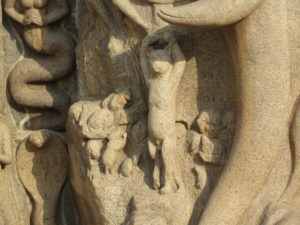Visiting Mahabalipuram – go ahead, google it
May 14, 2010
On arrival to Mahabalipuram, we were meet by a one-armed monkey. He (or she) didn’t say why the one-armedness, so I had to do some supposing. Maybe an accident? (Cars drive quickly here.) A fight? (Lots of other monkeys hanging around) A cruel trick (You know humans) Or maybe she (or he) was the one monkey in a million that fell out of a tree. Didn’t seem to faze the fella much. Still got around easily, with no complaints. Amazing creatures, those furry little animals wandering about the heritage site. There was a quite fat one, a little one, the one-armed one…and all of them climbed, ran, etc. Meanwhile the humans were sweating it out in air-conditioned cars and a few had trouble climbing the low level rises that connected the several temple caves that make up Mahabalipuram. Oh, to be an animal. But then, would that mean missing out on the appreciation of the rich mythological carvings that inhabit the rock caves of Mahabalipuram?
The first image you see in this rocky expanse of a park is a tremendous single rock cliff carving that is tight with images of flying couples, elephants in motion, people doing penance, a cat praying, serpent women descending (or ascending) a cleft in the cliff where water once flowed and a corner of the image unfinished, just ghosts of what was to come (a couple of cow’s heads?). Called Arjuna’s Penance, there is some argument as to whether this is about the legendary figure of Arjuna or an image depicting the descent of the goddess Ganga, who became the river Ganges. I have my guesses, but I remain quiet. I say this because this is where part of my Fulbright project will occur. I will bring a total of 160 children here to view these carvings and interpret for themselves what the story is telling, for them to then dramatize their interpretations.
As you wander the rock steps here, you come to several other rocks that have been hollowed out and made into a small temple of sorts, with large carved panels on three sides. They all depict famous characters of mythology in famous battles or actions, though some are a mix of story images that don’t necessarily follow the artistic norm of the time. To stand in the shade of the rock caves and view these panels is an imaginative joy, which I look forward to sharing with the children. Ideally, through this project, they will gain a little more ownership of a piece of heritage that most of them rarely experience or may do so perfunctorily.
As I wandered the place with my friends and colleagues, they decided to go back to the car and drive around to the other side. A young man and I braved the heat and sun and walked on, having the unique pleasure of climbing a set of steep, stone cut steps (were the people who lived here that tall?) and standing atop a temple roof that gave us a 360 view of the area, from sea to the backwaters inland.
As we descended amidst the monkeys and pigs and various postcard hawkers (is there a place where postcards aren’t sold at the bottom of a pathway?), I did not see the one-armed monkey again. But I will be back, so maybe I’ll say hi to him again later (or her).
